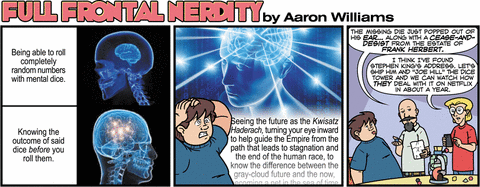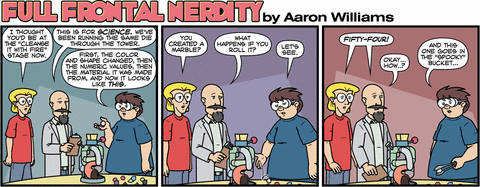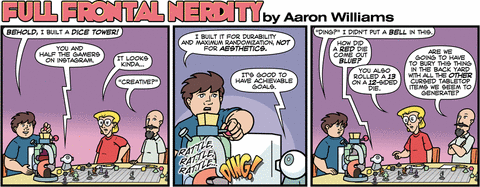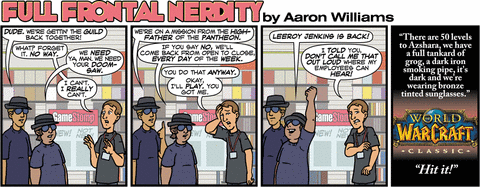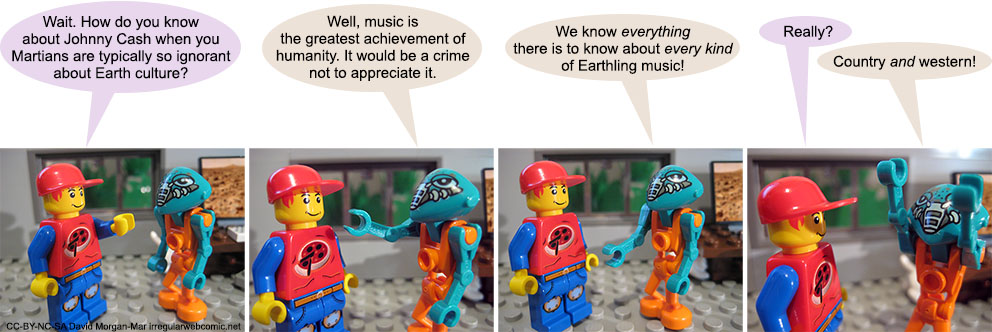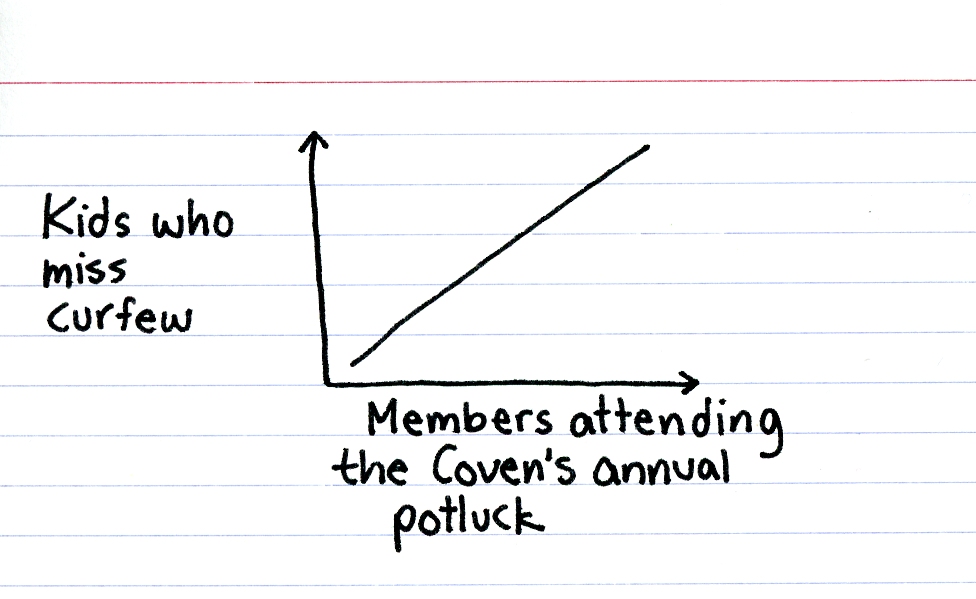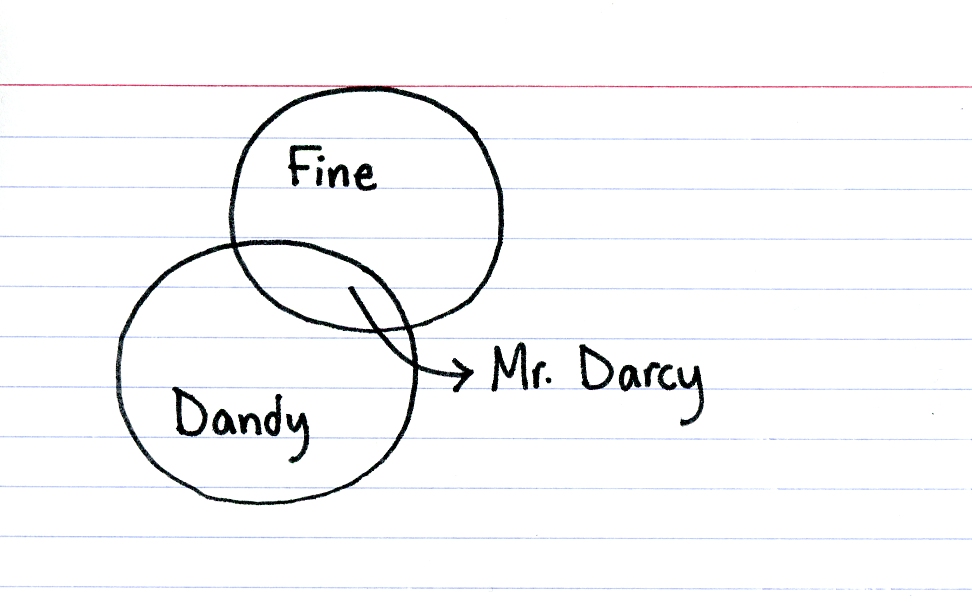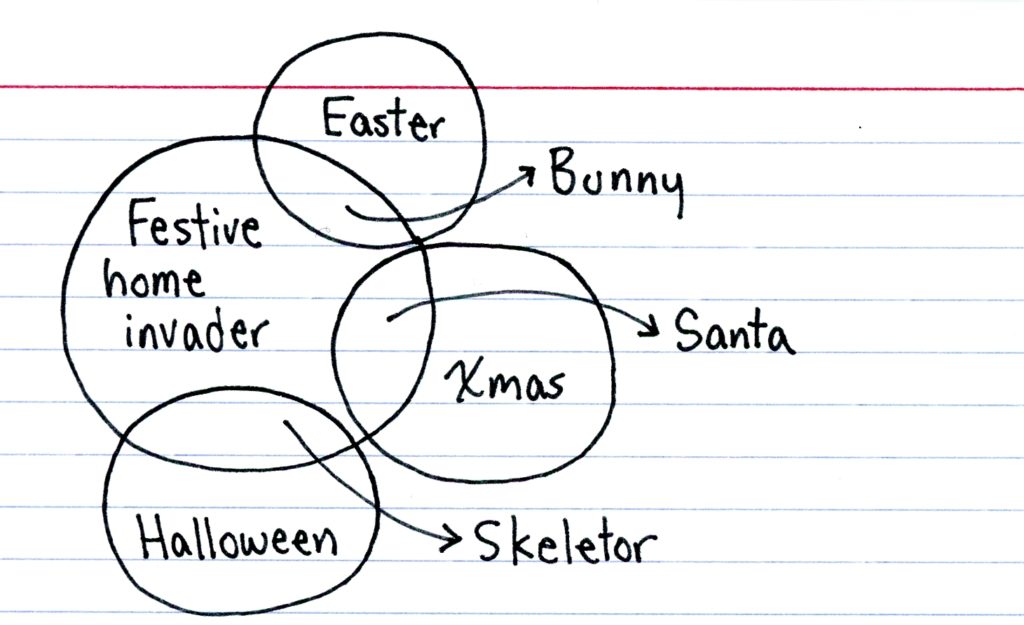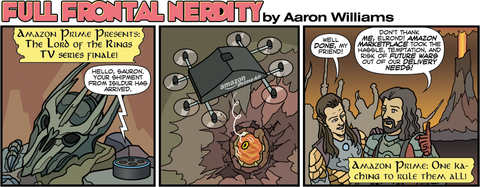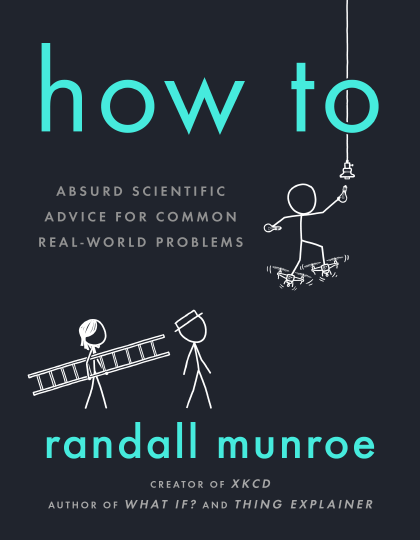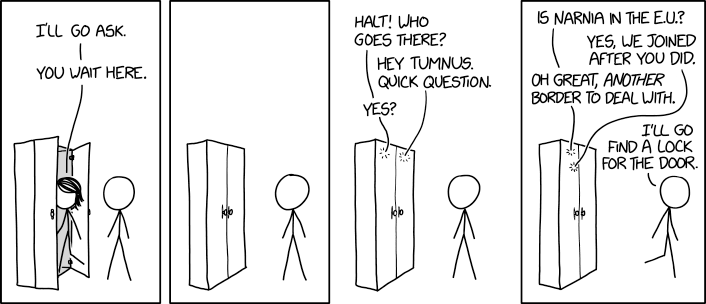
Shared posts
The must-have accessory for all outfits.

The post The must-have accessory for all outfits. appeared first on Indexed.
Irregular Webcomic! #2001 Rerun

Aha! You didn't expect that one, did you? :-)
There are so many good quotes from The Princess Bride.
I did have to modify this one slightly from the canonical version, to better fit the comic. But I'm sure if you know the film you would have got it ayway.
2019-09-29 Rerun commentary: It's interesting that Giuseppe thinks "Infinite Featureless Plane" is a precise enough address for a pizza delivery. Not even a street number or the name of the nearest cross-plane.
Alec C. pointed me at What 3 Words, which I was previously unaware of, and which maps 3×3 metre squares of Earth to unique combinations of three words. Unfortunately "infinite featureless plane" is not a valid What 3 Words address, but the closest match is "infinite fatherless plan", which maps to a remote point near the Nullarbor Plain in South Australia, which is appropriately enough about the closest approximation to in infinite featureless plane that there is on Earth. So Giuseppe is not as vague as he seems. And can somehow convince an Uber Eats driver to deliver to one of the remotest locations on Earth.
We are so far beyond satire.

The post We are so far beyond satire. appeared first on Indexed.
How to Send a File
My new book, How To: Absurd Scientific Advice for Common Real-World Problems, comes out in a week! You can preorder it now on Amazon, Barnes & Noble, IndieBound, and Apple Books.
Here’s an excerpt from the How To chapter on file transfers.
Chapter 19: How to Send a File
Sending large data files can be difficult.
Modern software systems have moved away from the concept of “files.” They don’t show you a folder full of image files; they show you a collection of photos. But files linger on, and will probably continue to do so for decades to come. And as long as we have files, we’ll need to send them to people.

The simplest, most obvious way to send a file is to pick up the device the file is stored on, walk over to the intended recipient, and hand it to them.

Carrying computers can be difficult — especially the earlier ones that were the size of a whole room — so rather than carry the whole computer, you can try detaching a piece of the computer containing the file. You can then bring this piece to the other person and let them transfer it to their own device. On a desktop-style computer, the files may be stored on a hard drive, which can often be removed without destroying the computer.
On some devices, though, file storage is permanently attached to the electronics, making removal more challenging.

A more convenient and less destructive solution is removable storage. You can make a copy of the file, put it on a device, then give the device to the person.
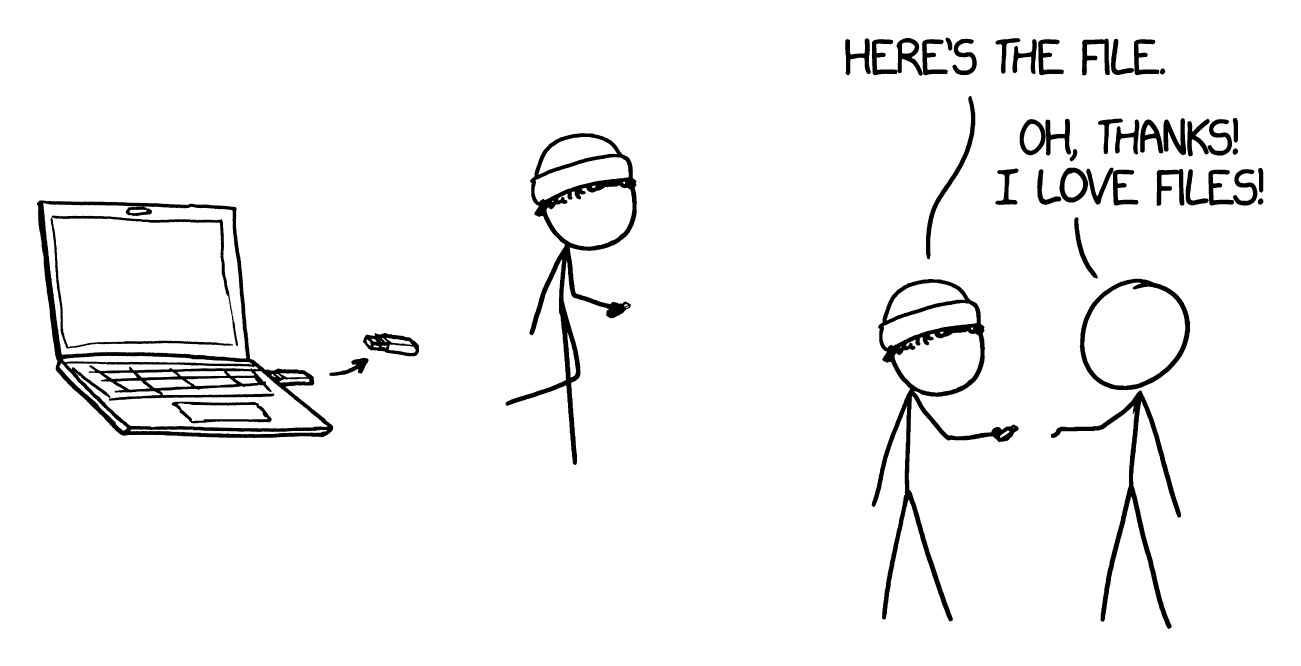
Carrying storage devices around is a surprisingly high-bandwidth way to transfer information. A suitcase full of MicroSD cards contains many petabytes of data; if you want to transfer very large amounts of data, mailing boxes of disk drives will almost always be faster than transferring them over the internet.
If you want to send data to a specific location that’s too far to walk, but not convenient to reach by mail — say, a nearby mountaintop — you could try using some kind of autonomous vehicle to carry it. A delivery drone, for example, could easily carry a small satchel of SD cards containing terabytes of data.
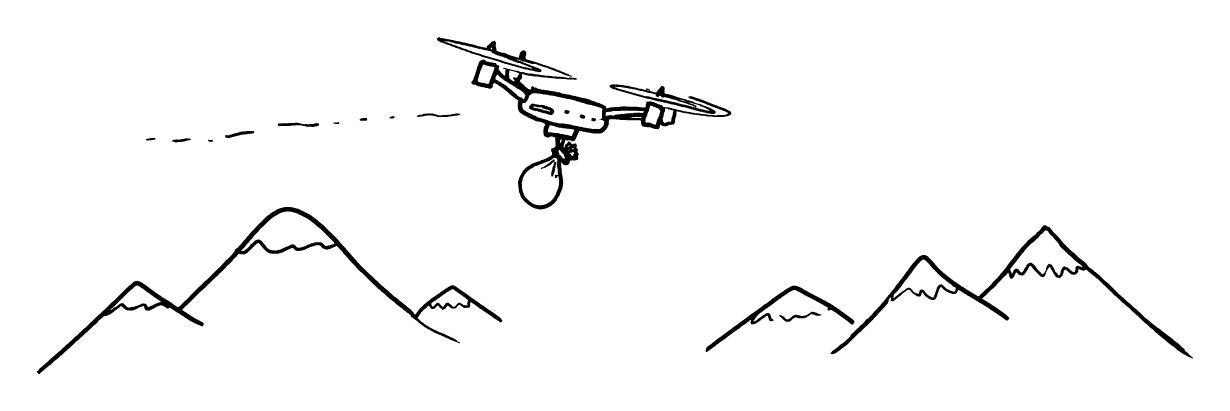
Quadcopter-style drones don’t work very well over long distances thanks to the limitations of batteries. If a drone has to carry its own battery, it can only hover for so long. If it wants to hover longer, it needs to carry a bigger battery, but that means more weight and faster power consumption. For the same reason that a house supported by jet engines [Note: For more on hovering houses, see Chapter 7: How to Move] can only hover for a few hours, small coaster-size drones typically have flight times measured in minutes, and the larger ones used for photography are usually limited to less than an hour in the air. Even if it flew very fast, a tiny drone carrying a MicroSD card could make it just a few miles before running out of steam.
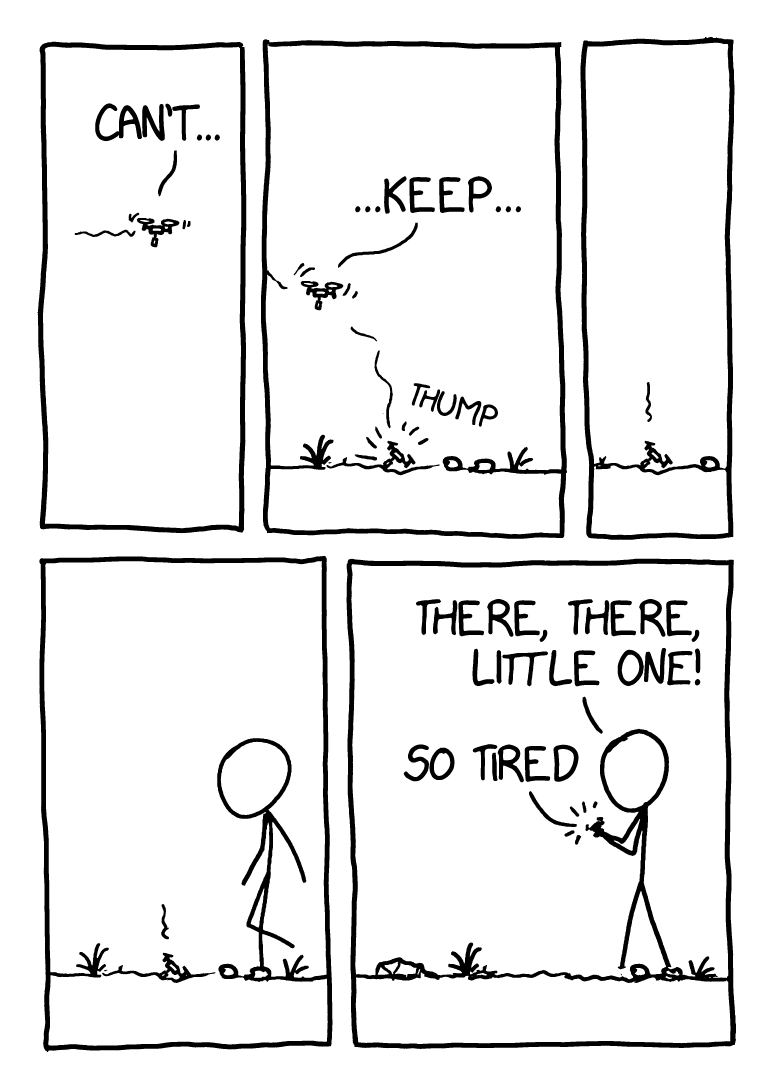
You could increase your range by making the drone bigger, adding solar panels, flying higher, and going faster. Or you could turn to the real masters of efficient long-distance flight:
Butterflies.

Monarch butterflies travel thousands of miles during their migration across North America, with some traveling all the way from Canada to Mexico in a single season. If you look up during the spring or fall on the East Coast of the United States, you can sometimes spot them gliding by silently overhead, a few hundred feet above the ground. Their extreme range puts drones — and even many large aircraft — to shame.
You might think butterflies have an unfair advantage over battery-powered aerial vehicles, since they can stop to consume nectar and “recharge.” Butterflies will certainly refuel if they can, but they don’t necessarily need to. Another butterfly species, the painted lady (Vanessa cardui), is even more impressive: it flies from Europe to central Africa, a 4,000-kilometer flight that takes it over the Mediterranean Sea and the Sahara desert.
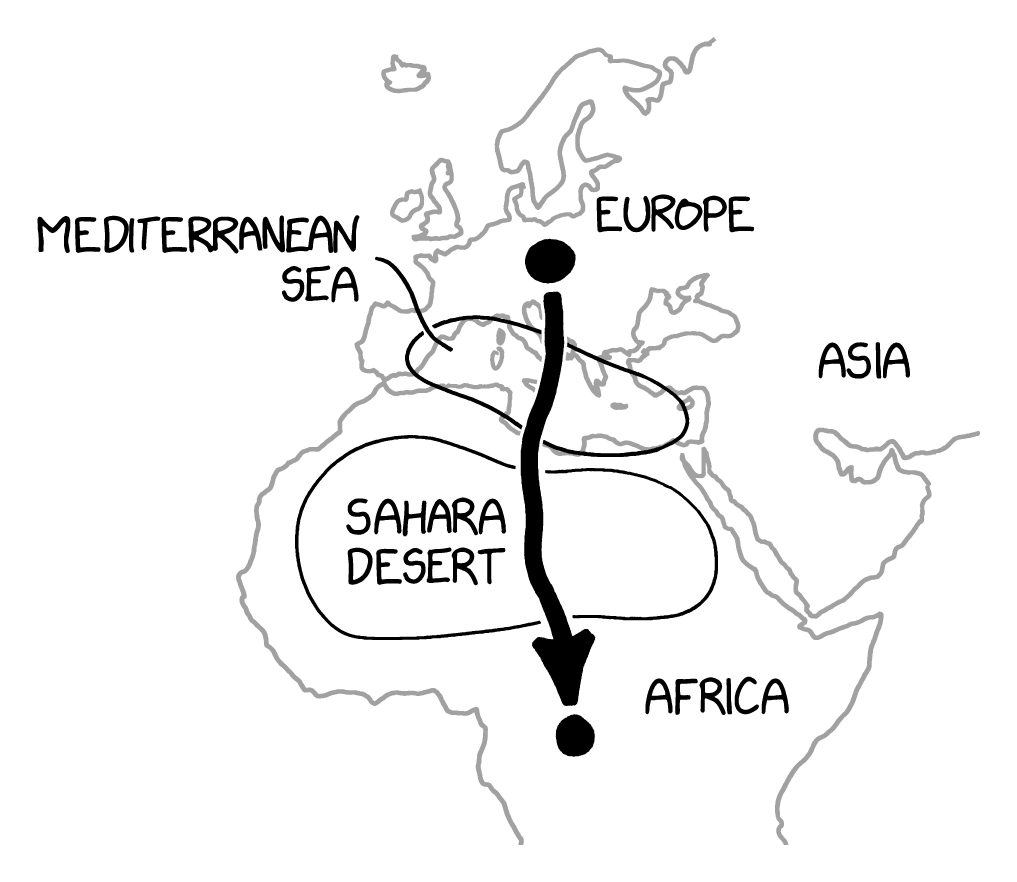
Butterflies make these journeys powered only by small reserves of stored lipids. They can fly so much more efficiently than drones in part by soaring — they seek out thermal columns and mountain waves, then hold their wings steady and ride the rising air upward like a vulture, hawk, or eagle.

If you want to send your file to someone who lives along the migration route, could you get a butterfly to carry it for you?
Butterflies can carry weights. Volunteers with groups like Monarch Watch tag tens of thousands to hundreds of thousands of monarch butterflies each year to track their migration and monitor their population (which has been in decline in recent decades). The smaller tags weigh about a milligram, but monarchs have completed their migration with larger tags that weigh 10 mg or more.
MicroSD cards weigh several hundred milligrams — comparable to the weight of a butterfly — so butterflies would have a hard time carrying them. But there’s no reason a storage device can’t be made smaller. MicroSD cards contain memory chips, and the storage density of these chips might be up to a gigabyte per square millimeter. Given those sizes, a butterfly could easily carry a tiny chip with a gigabyte of data. If your file is larger than that, you could break it up across multiple butterflies, and send multiple copies for redundancy.
When your data finally arrived at its destination, the recipient would have to check a lot of butterflies to assemble all the pieces of the file. You may need to develop some kind of touchless butterfly scanner that allows them to scan many butterflies at once.
You could avoid that problem — and increase your bandwidth dramatically — by using DNA-based storage. Researchers have stored data by encoding it into a DNA sample, then sequencing the DNA to recover it. Systems like this can achieve densities far beyond anything we do with chips — it’s possible to store and recover hundreds of petabytes of data using a single gram of DNA.
Each year, tens to hundreds of millions of monarch butterflies arrive in Mexico to spend the winter together in giant colonies in the mountains. If you tagged ten million of these butterflies with tiny pouches containing 5 mg of DNA storage each, the total capacity of the butterfly armada would be about 10 zettabytes — 10,000,000,000,000,000,000,000 bytes. That’s roughly the total amount of digital data in existence in the late 2010s.
If the Sun is warm, the winds are favorable, and it’s the right time of year, you could use butterflies to send someone the entire internet.

How To: Absurd Scientific Advice for Common Real-World Problems will be released on September 3rd. You can preorder it now on Amazon, Barnes & Noble, IndieBound, and Apple Books.
Get that cake.

The post Get that cake. appeared first on Indexed.
Serena Versus the Drones
My new book, How To, comes out on September 3rd (preorder: Amazon, Barnes & Noble, IndieBound, and Apple Books).
One of the most exciting things about writing How To was that, for a few chapters, I was able to reach out to some extremely cool people who were willing to apply their unique expertise to ridiculous tasks. Among those who generously agreed to help was Serena Williams.
Here’s a portion of the chapter “How to Catch a Drone”, in which Serena helped test whether tennis serves could be an effective countermeasure against flying robots … by taking a drone out onto a court and hitting tennis balls at it until it crashed.
How to Catch a Drone
A wedding-photography drone is buzzing around above you. You don’t know what it’s doing there and you want it to stop.
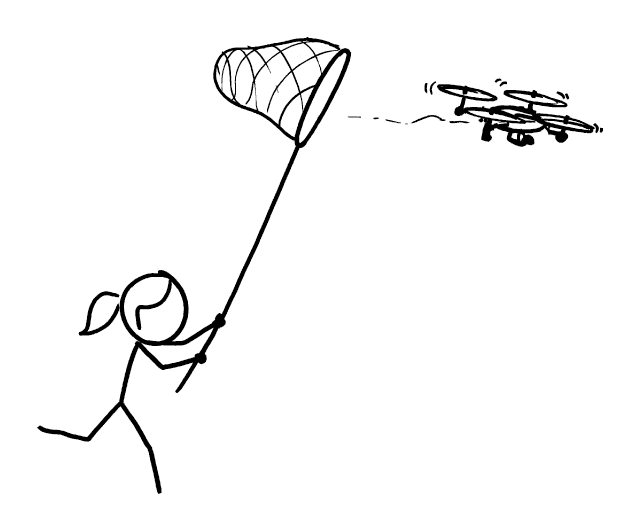
Let’s suppose you have a garage full of sports equipment— baseballs, tennis rackets, lawn darts, you name it. Which sport’s projectiles would work best for hitting a drone? And who would make the best anti-drone guard? A baseball pitcher? A basketball player? A tennis player? A golfer? Someone else?

There are a few factors to consider — accuracy, weight, range, and projectile size.
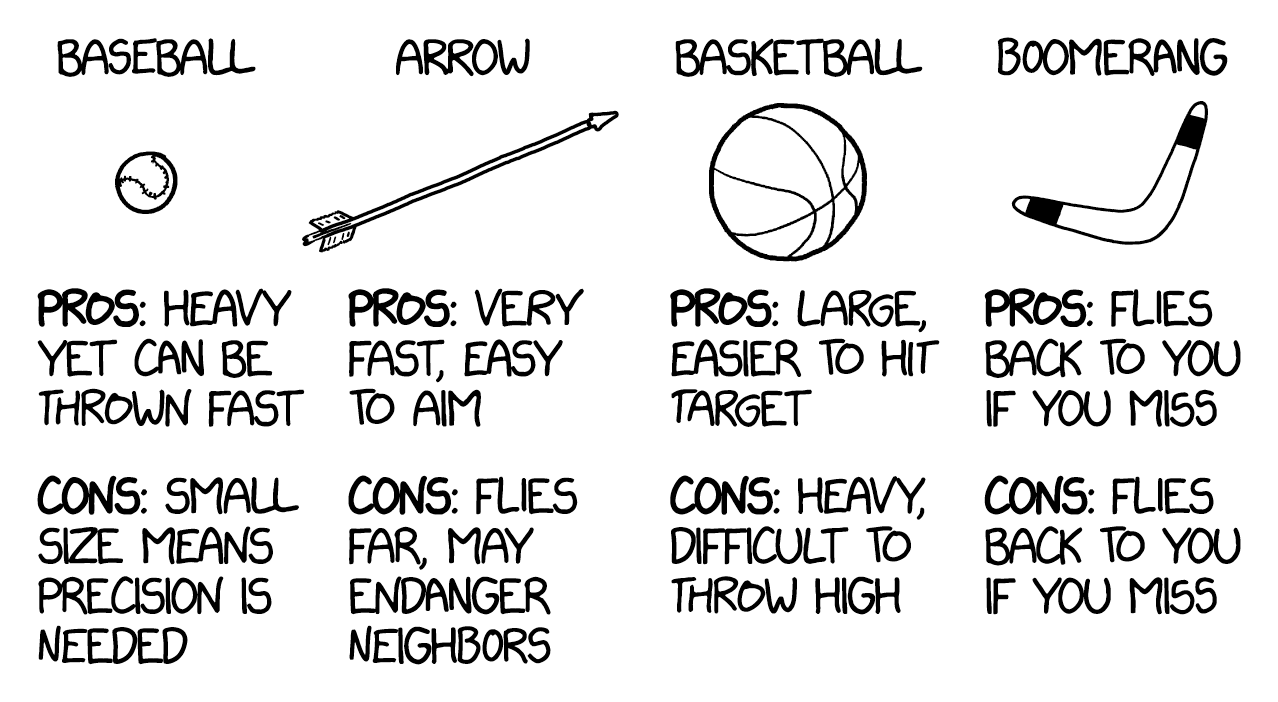
One sport I couldn’t find good data on was tennis. I found some studies of tennis pro accuracy, but they involved hitting targets marked on the court, rather than in the air.
So I reached out to Serena Williams.
To my pleasant surprise, she was happy to help out. Her husband, Alexis, offered a sacrificial drone, a DJI Mavic Pro 2 with a broken camera. They headed out to her practice court to see how effective the world’s best tennis player would be at fending off a robot invasion.
The few studies I could find suggested tennis players would score relatively low com- pared to athletes who threw projectiles— more like kickers than pitchers. My tentative guess was that a champion player would have an accuracy ratio around 50 when serving, and take 5–7 tries to hit a drone from 40 feet. (Would a tennis ball even knock down a drone? Maybe it would just ricochet off and cause the drone to wobble! I had so many questions.)

Alexis flew the drone over the net and hovered there, while Serena served from the baseline.
Her first serve went low. The second zipped past the drone to one side.

The third serve scored a direct hit on one of the propellers. The drone spun, momentarily seemed like it might stay in the air, then flipped over and smashed into the court. Serena started laughing as Alexis walked over to investigate the crash site, where the drone lay on the court near several propeller fragments.
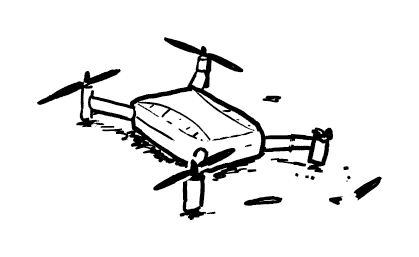
I had expected a tennis pro would be able to hit the drone in five to seven tries; she got it in three.
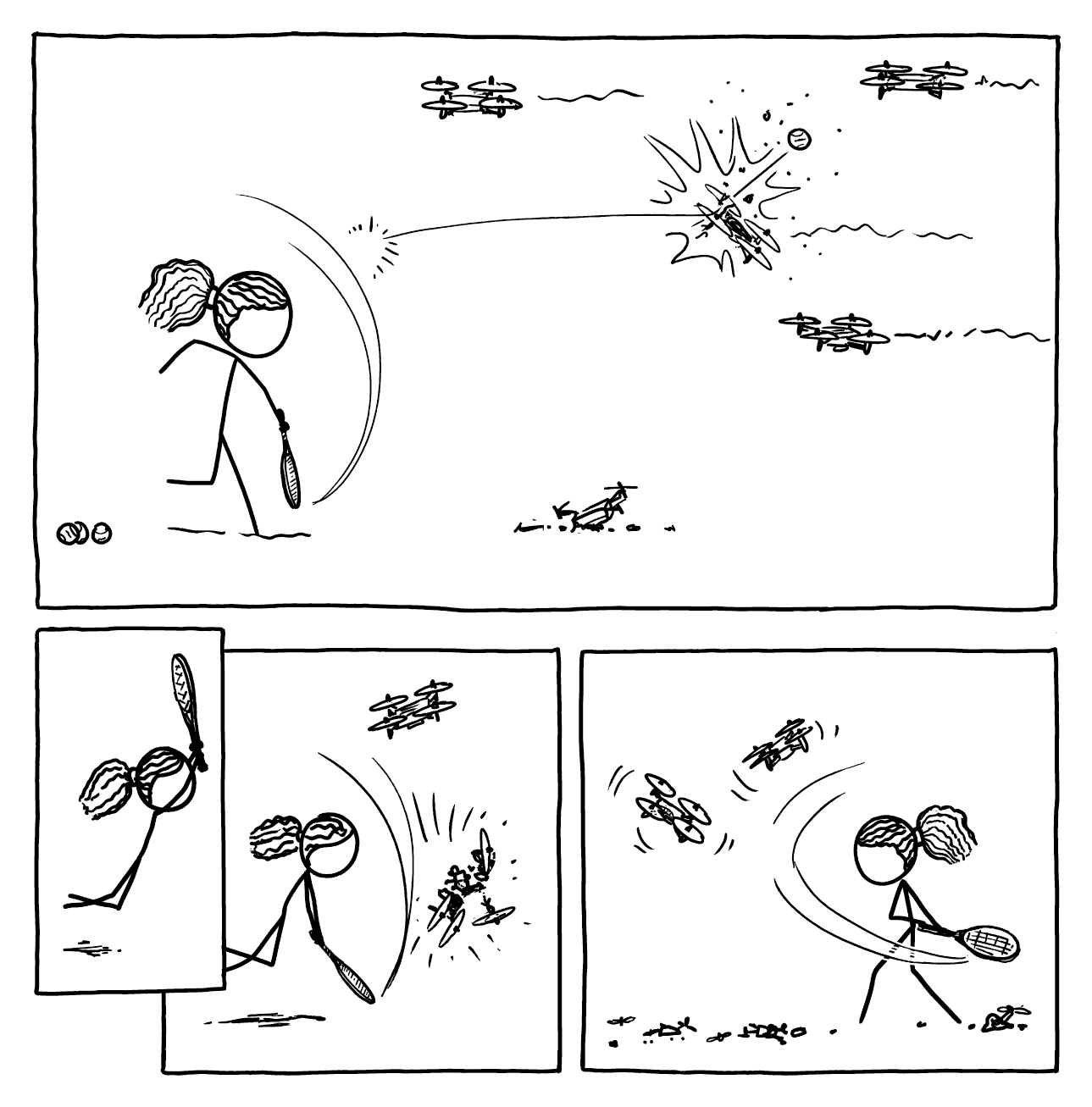
For more on anti-drone strategies, sports projectile accuracy, a discussion with a robot ethicist about whether hitting a drone with a tennis ball is wrong, and many other topics, check out How To: Absurd Scientific Advice for Common Real-World Problems, available September 3rd (preorder: Amazon, Barnes & Noble, IndieBound, and Apple Books).
How to walk a human being
TomfhainesPippa sent this to me....
When Having Friends Is More Alluring Than Being Right
“There’s this flat-earther documentary called BEHIND THE CURVE,” my wife said. “We have to watch it!”
Of course we did. My wife will occasionally get into huge debates with flat-earthers on Facebook, dutifully reporting back on all the idiocy she dug up that day.
Now, I didn’t care much about flat-earthers, but I care very much about the amusement of watching my adorable wife get worked up about these dippy-doodles, so… we watched.
Except the flat-earthers weren’t dippy-doodles.
They were just lonely.
Which is not to say that each of them didn’t believe in the flat earth – oh, they did – but most of the people interviewed had a similar path to getting so deep into flat eartherism that they spent their own money to fly out to flat earth conventions:
1) They sorta believed that the earth was flat.
2) They told their friends, who either blew them off or mocked them or both.
3) They found a group of flat-earthers online, who were very welcoming and happy to find a fellow flat-earther.
4) Slowly, these people abandoned their old friends and converted to the new folks, who’d never tell them they were wrong about the flat-earth. Which had the side effect of making their flat-earth beliefs the most prominent part of their personality.
5) Eventually, the rejection becomes the proof that they’re on the road to truth, and no amount of evidence will convince them because this is no longer about logic – it’s about using their own logic to build a shield to protect them from rejection.
I wound up admiring the flat-earthers – some were funny, some were smart aside from the flat-earth stuff, some were compassionate. But the most telling part was at the end, when they interviewed one of the most devoted flat-earthers and asked him (I’m paraphrasing):
“What if you got irrefutable proof that the Earth was round? You’d lose all your friends. Could you walk away from this culture you helped create?”
And to his credit, he answered honestly:
“No. No, I don’t think I could.”
At which point I flung up my hands and cried, “What do you do?”
Because at this point, there’s a whole community which is united by one common principle: We didn’t like being told we were wrong, so we found somewhere that told us that we were right.
How do you fight that? Either you take these people with their whackadoodle ideas and go, “You know, you have a point, the earth is shaped like a kitten” – at which point you give acceptability to those answers – or you tell them they are factually wrong, at which point they’ll be so stung by the rejection that they’re vulnerable to being picked up by communities that embrace these wrongheaded opinions.
And if it was just flat-earthers, I’d say fine, it’s harmless. But you’ve got anti-vaxxers and Men’s Rights Advocates and anti-global warming folks and TERFs and incels out there, all fueled by one central pivot point of humanity – namely, that it’s lonely being wrong.
Except the internet has made wrong people folks to be courted. In fact, the more wrong people you can get on your side, the less you’ll be lonely. And the only cost to be a part of these groups is that you can never question the beliefs at the core of it, because that wrongness is what binds you, and any evidence that contradicts that wrongness must be either discarded, attacked, or humiliated.
It’s not a good look.
But to quote Billy Joel, it’s better than drinking alone.
And sometimes, that welcoming Internet has been a lifeline to people – I mean, hell, folks with all sorts of kinks can get together on FetLife, gays and trans folks can congregate to see that they’re not a freakish as their families would have them believe. And though there’s always more human messiness in the world of science than most science advocates would care to acknowledge, the truth is that most scientists are happy to be proven wrong by a replicable, verifiable study – they’re seeking the truth, not the hypothesis.
But I think of that flat-earther – charming, witty, funny – and how the Internet guided him into a place where he became a minor celebrity among the flat-earthers, taking a nameless dude from nowhere and elevating him to the point where Netflix is making a documentary about him and his buddies.
The Internet creates communities.
It does not care whether those communities’ beliefs have any relation to the truth.
And the scary part is that in practice, the Internet may be more fertile in creating communities that oppose the truth – because the folks who genuinely believe that, say, manure is good fertilizer for a garden or that some brands of 3D printers clog less than others have little need to defend themselves.
But the people who believe bullshit? They need other people who believe bullshit to help hold them together. And as such, they’re a little friendlier, a little more willing to outreach, a little more desperate for new buddies.
Because as long as they have someone to back them up, they’re not a crank – they’re a part of a grand rebellion, peeling back the layers The Man has laid down to uncover the pulsing, vital truth.
And what’s more life-affirming than that?
There’s been discussions about how physical community used to give people a sense of meaning – yes, those churches and Elks clubs may have been biased, but they helped you feel like you were actually a part of a larger whole. Which is something people have searched for throughout history.
I think, perhaps, by inventing the Internet, we’ve created a medium that leverages our sense of community with no outside forces to counteract that. Normally, in a town with 100,000 members, you could see that you were the only one who believed that balloons were the breath of the antiChrist and go, “Huh, I may be right, but… I’m gonna have to convince a lot of people face to face.”
These days? Your community is a click away, that sweet sweet justification a continual flow, and if you never step outside of your house you’ll never meet anyone face to face who’ll tell you you’re wrong. It’s just a bunch of faceless people, easily dehumanized. Whereas your friends, who are also words, speak to your heart.
How do you fight that? And here is where I wish I had an answer, but man, whatever the solution is, it won’t be simple. Ban them? They go elsewhere and feel like this is their personal diaspora. Throw facts at them? Their whole community makes them impervious to facts. Abandon them? They never needed you.
I don’t know how you fight it. But it’s there. And the real solution is to teach people that maybe not everything that makes you feel good IS good for you, but we’ve been trying to teach folk that forever that that trick never works, Rocky.
But there’s a community that believes the earth is flat. They’re friends because of that fact. Dissolve the fact, their friendships are lessened.
Would you give up your best friends in search of the truth? Speaking frankly, few people have. And I think that’s why it’s gonna get a lot worse before it gets better.
Irregular Webcomic! #3998

Natron is a naturally occurring mixture of salts, mostly hydrated sodium carbonate with some sodium bicarbonate and traces of other sodium salts. It's typically found in dried up lake and river beds. The word natron comes from Wadi El Natrun the place in Egypt where the ancient Egyptians mined the salts for use in preserving bodies for mummification. They referred to the salts as ntry. This passed into Ancient Greek as νίτρον (nitron), and thence into Latin as natrium. And this is why the chemical symbol for sodium is Na - it comes from the Latin, but ultimately derives from Ancient Egyptian. How cool is that?
Irregular Webcomic! #3990

Thanks to my circle of gaming friends who took this topic and ran with it, providing me enough material for three strips.
Our Latest Dorky Adventures
My wife hates trinkets – she wants a clean house, and all the little promo items we pick up at conventions are her enemy. So we’ll get a free collectible coin for seeing ENDGAME on opening night, and she’ll toss it. If work sends me a promotional Magic mat, she’ll give it away to our godchildren. She wants nothing – nothing – in the house that is not functional.
But when I bought Sekiro, a PlayStation game, they gave me a plastic samurai sword letter opener. It even came on a little stand. And she was away that weekend, so I became attached.
“Get rid of it,” she said.
“It’s useful!” I cried.
“What the hell use do you have for a cheap plastic letter opener?”
I stared her right in the eye. “Home defense.”
“Home defense?”
“It’s small. It’s concealable. They’ll never see it coming.”
She rolled her eyes and left me alone.
And then, hours later, when she was lying on the couch reading a book, I walked up for a kiss. She puckered her lips, and – AH HA! –
Samurai sword at her throat.
She never saw it coming.
“See?” I said, then kissed her on her stunned lips and danced away.
Over the next few weeks, she came to understand the power of stealth that was a cheap knockoff promo samurai sword. She’d be in the tub. She’d be downstairs sewing. She’d be going in for a cuddle, and – AH HA! –
Samurai sword.
I was, indeed, a ninja.
But the sword vanished the day after trash day, so I figured that Gini had finally gotten tired of me being a dork and had chucked it, which, you know, fair enough. Certainly I got more entertainment out of that than most plastic. And we curled up on the couch to watch Game of Thrones, when – AH HA!
Samurai sword at my throat.
“You are not the only ninja,” she said, and I realized that a war had begun.
Andromeda Part 25: BioWare is Dead
If you’re reading this series, then you’ve probably already heard the news that BioWare says they’re not done with Mass Effect. Of course, they listed Mass Effect 3 and Andromeda as possible launching off points for future stories. Their first instinct is to build on the games with the weakest stories, which probably indicates that any future titles would be more of the same.
Guys! Mass Effect 2 is the fan favorite! Sure, story dorks like me would whine all the way through it, but it’s the strongest in terms of fan support. If you’re going to copy a previous game, copy the popular one!
I think it’s safe to say that BioWare is now completely divorced from their brand as developers. Andromeda was their big chance to start over with a clean slate, and it was a sad imitation that missed the point on every level. This is a company that banks on their reputation as storytellers that no longer knows how to tell a story.
But Shamus, this game came from a new studio! This shouldn’t reflect on the rest of BioWare!
If anything, that’s the most damning fact of all.
Blame Goes Uphill

The Andromeda team was led by people from the main BioWare studio, and by necessity the blame for this trainwreck belongs to those people. Maybe the leadership hired incompetent people when filling out this new studio. Maybe they hired good people but forced them to make a game based on this incompetent story. Maybe they hired a mix of people but management had no idea how to differentiate good work from bad work.
It’s not like this story was a good idea with a couple of bad spots, or something could have been saved with more polish. This story was atrocious. This is a moronic story concept with an infantile villain and a shallow understanding of the sci-fi genre. This story couldn’t even rise to the level of shallow action schlock, much less the level of brainy details-oriented science fiction. We had two plots in this game[1], both of them were dumb, neither of them fit the established setting, and they were fundamentally at odds with each other.
Maybe with more time and money you could have fixed the bugs, the animations, the audio, the game balance, and all the other technical problems this game had, but none of that would change the fact that the entire game was built atop this terrible narrative foundation. There’s no escaping it. The blame for this has to land in the lap of the creative leads.
I realize I’m very close to breaking my own protocol by making this personal. Elsewhere in this series I refer to the writing and design staff as “the writer” so that we don’t focus on single people, because I’m more interested in diagnosing problems than identifying culprits. But when we start talking about “the leadership”, we’re talking about a much smaller and more specific group of individuals. At this point we’re pretty close to pointing fingers.

On the other hand, blame needs to go uphill. The leadership either mandated terrible ideas, or they approved of terrible ideas from other people, or they sat back and allowed terrible ideas to take root. At the start of this series I linked to The Story Behind Mass Effect: Andromeda’s Troubled Five-Year Development. It’s a long, grim article that gives us a glimpse into Andromeda‘s troubled development. There were a lot of problems, but almost all of them are the result of poor leadership in one way or another. This game wasn’t sabotaged from above by corporate politics, or the victim of bad timing in the market, or rushed out the door[2]. It didn’t run out of money. Certainly EA’s mandate to use the Frostbite game engine didn’t do Andromeda any favors, but that doesn’t explain why the villain is so embarrassing or why nothing makes any narrative sense. Someone approved of all of these incoherent sidequests, lame characters, and unsatisfying choices. The blame for that has to land in the laps of the BioWare leadership.
I realize that a lot of people poured years of their lives into this project. That list of people includes the leadership I’m criticizing. Maybe I’m being a jerk by calling out the guilty in public, but it doesn’t feel right to dance around this topic. I feel bad for the talented people who saw their hard work turned into a bad game, but the first step in making sure that doesn’t happen again is holding the right people accountable. Maybe I’m being cruel, but having the same leadership try again with the same terrible approach would be even more cruel.
Tone at the Top
|
Link (YouTube) |
In the past I’ve talked about things like “corporate culture” and “creative priorities”. In accounting they call it Tone at the Top. It’s the idea that, since most people want to keep their boss happy and that boss wants to keep their boss happy, the highest people in a company have tremendous influence over the attitudes and behaviors of the people far below them. If the leaders are duplicitous, sneaky, ruthless, and calculating, then their accounting staff will gradually lean towards being more duplicitous, sneaky, ruthless, and calculating. People that dislike that sort of environment will leave and people that thrive in those conditions will get promotions. Likewise if the leadership is scrupulous, cautious, and bureaucratic, then the accountants will tend to lean that way as well.
While this theory is mostly concerned with the prevention of accounting fraud, it can easily be expanded to encompass all sorts of corporate behavior, including creative endeavors. When you spin up a new studio, the existing leadership is in charge of hiring the new staff, setting the tone of the office, and making the studio priorities clear. If you hire people with a background in speculative fiction and tell them to make you a game that captures the spirit of Bradbury, Asimov, and Roddenberry, then that’s what the team will try to do. They might not succeed, but you’ll have a shot at making the kind of product you value. On the other hand if you hire a bunch of people who enjoy shooters and you tell them you want an action game that contains a laundry list of popular shooter features, then that’s what they’ll try to make.
Looking at the state of Mass Effect Andromeda, I think it’s safe to assume that there’s nobody in the BioWare management that knows how to create a studio to tell a story. It’s not that the designers are bad at worldbuilding, it’s that they went to ridiculous lengths to avoid doing it altogether. This story takes place in a setting with one new alien species and one conflict. The world constantly references alien technology and local history without ever adding details to either one. This is the narrative equivalent of a Mario-style platformer that takes place entirely on a flat plane with no hazards. There’s nothing to engage with here.
Imagine that Call of Duty gets handed off to a new studio, and the resulting game has almost no shooting in it. Instead it has cutscenes, minigames, lever puzzles, driving sections, romances, jumping puzzles, skateboarding, brawling mechanics, tower defense and chocobo racing. The developer bent over backwards to put anything in the game that wasn’t shooter gameplay, and they only included as much shooting as required to justify the title. I would say that is a developer that is ill-suited for the material. And yet that’s what BioWare has become. A company ill-suited to create the kind of content they’re known for.
Maybe it’s tempting to imagine that Andromeda was just plagued by technology problems and that if they just had a little more time and money this could have been a return to form for the studio, but the rot goes deep. This isn’t a diamond in the rough. This is a simple story with nothing to say and a childish bore of a villain, shot through with mangled tropes and suffering from a pervasive lack of narrative ambition… in the rough.
Re-Creating the Magic of Mass Effect

I’ll admit they tried. The team went out of their way to capture as many aspects of the franchise as they could, with a special effort made to copy the first game. The imitation is so deliberate it almost forms a New Hope / Force Awakens situation where it becomes distracting.
-
- Squad members: Male and female human squaddies for our straight romance options. One is a biotic prodigy and the other comes from a military background. (Kaiden+Ashley / Cora+Liam[3])
- Squad member: A Turian maverick (Garrus / Vetra)
- Squad member: A young Asari studying ancient alien technology. (Liara / Peebee)
- Squad member: An old Krogan warrior. (Wrex / Drack)
- Squad member: A purple / blue alien that comes from a very successful family and suffers from the high expectations that come with that. (Tali / Jaal)
- A father figure that exits the story so the player can take over. (Anderson / Your actual dad)
- A bouncy space-tank. (Mako / Nomad)
- A one-of-a-kind stealth ship with a black-and-white paint job. (Normandy / Tempest)
- A mystery involving ancient alien technology. (Protheans / Remnant)
- The hero mastering ancient alien knowledge. (The Cypher / Ryder’s Remnant Magic)
- A ginormous space station as the seat of power. (Citadel / Nexus)
- On the space station is a difficult bureaucrat you have to tangle with. (Udina / Tann)
- A chapter where you have to assault an enemy installation (Virmire / Kett conversion base) and nuke it, which leads to a moral choice at the end.
- A moment in act 3 where the political leaders oppose you and advise inaction, obliging the hero to go rogue.
- A search for a mystery world where we walk through ancient alien ruins and discover big plot-twisty things. (Ilos, Fake Meridian.)
- There’s an important thing at the end called “The Conduit”. (The mystery gateway to the Citadel from Ilos / The final boss monster.)
- A moment in act 3 where your team does a combat drop in your space tank on a strange new alien world, and then has to chase the villain to the final showdown where you fight over a control panel. (The chase on Iilos through the conduit to the controls on the Citadel / the chase on Meridian and into the vault for control of the vault network.)
- A choice at the end that allows you to shape the future government. (Save the council / Choose the Nexus leader.)
The problem wasn’t budget, the game engine, or a lack of respect for the source material. The problem was that the designer had no idea what parts of the original game were important. They looked at this universe bursting with history, nuance, intrigue, mystery, depth, and culture and they concluded the key features the audience wanted to see were a space tank and a Turian that doesn’t play by the rules. That’s like writing new material for the Harry Potter universe and concluding that the most important detail is to have a little boy with a forehead scar that lives under a staircase. Those are the details you shouldn’t keep!
After copying all of these superficial things, they completely whiffed on the important stuff. They whiffed so badly I don’t think they even understood it was important. It’s extraordinary the lengths they went to in order to avoid doing worldbuilding and telling stories. We arrive in a galaxy and meet ONE alien species. There’s no history or political intrigue. Even the events of the recent past (like the rebellions) are left completely vague. Quests come from datapads, are directed mechanically by an ever-present semi-omniscient narrator AI, offer nonsensical binary choices, and end with curt acknowledgement rather than dialog. The planets don’t have story arcs, but are rather a series of mechanical challenges involving driving, shooting, and jumping puzzles.
Full of sound and fury, signifying nothing.

Everything in Andromeda is constructed backwards. Instead of saying, “Here are the events of the past, what sorts of situations and stories would come from that?” the writer says, “I want the player to drive up this hill and shoot all the dudes at the top. What’s the simplest possible scenario I could use to justify that?”[4]
The player choices are few, arbitrary, poorly depicted, and lacking in interesting options. Dialogs are rare, linear, and lacking in player expression. The few characters you meet in the open world are shallow and bland. The villain is a sophomoric one-note bore. The worlds are, by design, a mostly empty wasteland with no history, culture, or wonder. Exploration of these alien worlds consists of driving around on pre-existing dirt roads[5] so you can gun down clusters of mooks.
The developer’s perception of what made the source material interesting is so wrongheaded that this project was in trouble before it ever left the dry-erase board. This team was not equipped to tell a space story on this scale. I don’t care if you’re talking about details-first or drama-first, this is not a storytelling team in any form. This storyteller might do an okay job if you want a linear shooter with fixed cutscenes and no player agency, but they’re completely unqualified to design a world to support dozens of hours of exploration, exposition, and player expression.
Hey Shamus, if blame goes uphill then shouldn’t the blame for this mess belong to EA?
There’s plenty of truth in that. I don’t mean to imply that EA is blameless in all of this. The reason the current leadership is running things is because the original leadership left, and they probably left because they didn’t like working for EA. But still, it’s not like this terrible story was demanded by EA. I’m sure EA doesn’t care about the story one way or the other, as long as the game sells. With a different leadership in charge of this studio, they could have slipped a smart[6] sci-fi story into this tentpole shooter.
I come to bury BioWare, not to praise them.

This company has lost its identity. Maybe they’ll solidify around a new identity and find success making some other kind of game, but waiting for BioWare to become BioWare again is like waiting for Mark Wahlberg to put out another hip-hop album with the Funky Bunch.
The dream is over. It’s time to move on.
But Shamus, the studio that made Andromeda was shut down. BioWare still has their Edmonton studio, and another one in Austin!
Their Edmonton studio just finished Anthem, a game specifically copying the style of Destiny. A studio that built its reputation on solid stories just entered a genre where gameplay is king and story is an afterthought. Like Andromeda, Anthem works very hard to avoid doing any worldbuilding. The world of Bastion is not one that invites curiosity and speculation or stirs the imagination. It’s a big canyon where you can shoot mooks for epic loot. It’s sort of a fun game, but it’s the opposite of everything BioWare was once known for.
BioWare Austin is still working on The Old Republic. I don’t think they’re going to be making us any story-based single-player experiences anytime soon, and I’m willing to bet on EA closing them down when TOR stops making money.
Over the last 10 years there’s been an incredible turnover in the leadership of BioWare. The old guard is gone, and that old guard is what gave the company its identity. Yes, I’m sure there are many bright minds and talented creative people at BioWare. In fact, I know there must be. There are some genuinely endearing moments and spectacular visuals in Andromeda, and those things are obviously the product of talent and hard work. But a handful of brilliant artists can’t change the direction of a company any more than a footsoldier can make changes to foreign policy.
So Long, and Thanks for all the Selkath
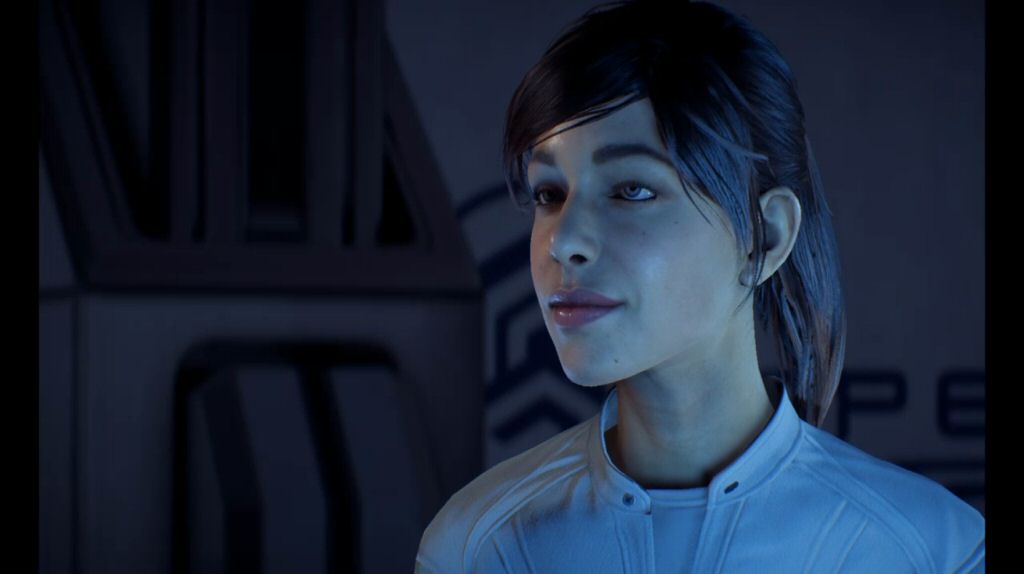
So BioWare is, in the sense of creating more games in the style of KOTOR or the original Mass Effect, dead. That’s a shame. Maybe it was unavoidable. Maybe there aren’t enough worldbuilding nerds out there to support these big-budget games. Maybe you have to appeal to the mainstream shooter crowd to make your money back, and maybe doing that will inevitably pull your game away from Tolkien-style runaway worldbuilding.
Maybe instead of pinning all our hopes on BioWare, we should put our hopes on some other studio, or perhaps even some future indie team. Maybe someone out there needs to scrape together five million bucks on Kickstarter and make a retro lo-fi RPG.
Yes, I know inXile did Wasteland 2 and Obsidian did stuff like Pillars of Eternity. But those are top-down number-crunchy games based on RTWP, and that’s not really my jam. I’m thinking of stuff more along the lines of KOTOR, Jade Empire, the first Mass Effect, and Dragon Age Origins. There’s a shift in narrative focus and visual presentation as you move from top-down to third-person that makes things a little more focused on characters and the personality of the central protagonist. Maybe that shift is what makes the game cost so much and pulls it away from its RPG roots towards the mainstream, but KOTOR made money back in 2003, and I’d like to think that sort of thing would still have a chance today as a mid-budget title.
It’s not like the genre is without hope. We’ve even got some AAA games to look forward to. We’ve got The Outer Worlds from the folks at Obsidian. Bethesda is working on Starfield. I know Cyberpunk isn’t the same as Trek-flavored sci-fi, but if you’re into worldbuilding then Cyberpunk 2077 is looking really good. I’m not crazy about Ubisoft these days, but they’ve apparently got some sort of sci-fi project called Pioneer in the works. They’ve also got Beyond Good and Evil 2 in development if you like your sci-fi to be less nerdy Trek and more campy Fifth Element. BioWare might be done telling stories and building worlds, but games with science fiction storytelling will continue to exist.
The genre has a future, even if BioWare won’t be a part of it. I’m sad to see the studio fall apart, but this has been a long time coming.
As a reminder, retrospectives like this are roughly novel-sized, and I put them up so we can all commiserate together. If you’d like to support my efforts, please consider joining my Patreon. Thanks so much for reading.
Irregular Webcomic! #3944

A portmanteau is a word formed by squashing two (or more) other words together. There may be an example or two hidden in the above comic. The word "portmanteau" itself was first used to describe such words by Lewis Carroll in Through the Looking-Glass. He took the word from its then-current meaning of a piece of luggage, describing the blended words as being "packed into one word like a portmanteau". He used it to describe some of the words he had made up in this way for his poem Jabberwocky, including "frumious", "slithy", and "mimsy". Interestingly, the English word "portmanteau" describing the luggage comes from the French portemanteau, which is itself a portmanteau word, combining the French words porter ("to carry") and manteau ("coat"). Interestingly, the English word "coat" is also a portmanteau, being a blend of the words "coaxial" (referring to the fact that when worn, a coat forms a coaxial sheath around the torso, in the same way as a coaxial cable[1]) and "tabard" (an old-fashioned type of tunic or coat - though obviously before the word "coat" was coined). [1] Coaxial cable was invented by English electrical engineer Oliver Heaviside[2]. Note that in his portrait he is wearing one of these newfangled coa-ts. (pronounced: co-ats) [2] Oliver Heaviside was also the person who introduced complex numbers into the mathematical treatment of electrical circuits. If you recall what I wrote about complex numbers in the annotation to strip #1960, the relevant part is that complex numbers can be used to represent waves (such as audio waves or electrical waves) in such a way that you can do the arithmetic of adding them up even when they are out of synch (or out of phase, in the correct jargon). This is very important for electric circuits that use alternating current, as alternating current is in fact a wave of electricity moving back and forth in the circuit. Heaviside was also one of the two people (together with American electrical engineer Arthur Kennelly) who independently predicted the existence of an ionised layer in the Earth's atmosphere, which would reflect or bend radio waves, thus allowing the observed but then unexplained phenomenon of radio signals being received far around the world from their transmission source. This layer is known as the Kennelly–Heaviside layer, or sometimes just the Heaviside layer, which will be familiar to aficionados of Andrew Lloyd Webber's musical Cats and the songs "The Invitation to the Jellicle Ball", and the penultimate "The Journey to the Heaviside Layer". (This comic is dedicated to those who thought I couldn't get references to Jabberwocky, complex numbers, atmospheric physics, and Cats into a single strip. You know who you are.)
How To: Absurd Scientific Advice for Common Real-World Problems
TomfhainesOoooh!
I’m excited to announce that I have a new book coming out! It’s titled How To: Absurd Scientific Advice for Common Real-World Problems, and it’s an extremely unhelpful guide to solving everyday problems.
How To is an instruction manual for taking everyday problems and using science and creative thinking to turn them into much bigger and more exciting problems. It teaches you how to cross a river by boiling it, outlines some of the many uses for lava around the home, and walks you through how to use experimental military research to ensure that your friends will never again ask you to help them move.
From changing a lightbulb to throwing a pool party, it describes unusual ways to accomplish common tasks, and analyzes what would happen to you if you tried them. In addition to being a profoundly unhelpful self-help book, it’s an exercise in applying math, science, and research to ordinary problems, and a tour through some of the strange and fun science underlying the world around us.
How To will be released on September 3rd, but you can preorder it now from Amazon, Barnes & Noble, Books-A-Million, Indie Bound, and Apple Books.
For more, you can check out my Q&A with Entertainment Weekly about the book, and you can find details about foreign editions at xkcd.com/how-to.

